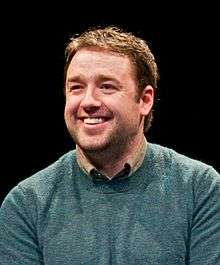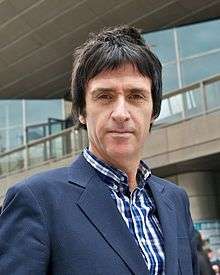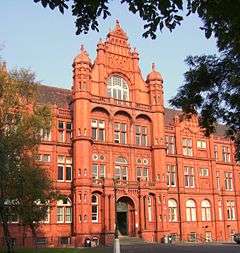University of Salford
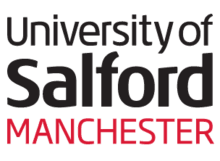 | |
| Motto |
Altiora Petamus "Let us seek higher things" |
|---|---|
| Type | Public |
| Established |
1850 - Pendleton Mechanics Institute 1896 – Royal Technical Institute, Salford 1967 – gained University status by Royal charter |
| Endowment | £0.49 m (2015)[1] |
| Chancellor | Jackie Kay |
| Vice-Chancellor | Helen Marshall |
Administrative staff | 2,781 |
| Students | 18,920 (2014/15)[2] |
| Undergraduates | 14,895 (2014/15)[2] |
| Postgraduates | 4,025 (2014/15)[2] |
| Location | Salford, Greater Manchester, UK |
| Campus | Urban, Parkland |
| Colours | Blue and Gold |
| Affiliations |
University Alliance Association of Commonwealth Universities North West Universities Association Northern Consortium |
| Website |
www |
The University of Salford is a public research university in Salford, England, 1.5 miles (2.4 kilometres) west of Manchester city centre. The Royal Technical Institute, Salford, which opened in 1896, became a College of Advanced Technology in 1956 and gained university status, following the Robbins Report into higher education, in 1967.
It has 18,920 students and is in 60 acres (24 hectares) of parkland on the banks of the River Irwell.
History
Origins of the Royal Technical Institute

The university's origins can be traced to 1896 with the opening of the Royal Technical Institute, Salford, a merger of Salford Working Men's College founded in 1858 and Pendleton Mechanics' Institute founded in 1850.[3] The Royal Technical Institute, Salford received royal letters after the then-Duke and Duchess of York (later King George V and Queen Mary) officiated at its opening ceremony, an event commemorated in the university's Redbrick Peel Building and which allowed 'Royal' to be appended to the name of the institute.
At the start of the 20th century, mechanical engineering, chemical works, textiles and construction dominated the industrial scene in Salford. This heavily influenced the choice of subjects offered in the nine departments initially opened. These were Engineering, Electrical Engineering & Applied Physics, Mathematics, Chemistry, Building, Dyeing, Spinning & Weaving, Domestic, and Art. Some 1,240 students registered for the first session in these departments. There were originally 19 members of staff.
In 1921 the Institute was renamed the Royal Technical College, Salford. In 1958 the institution split into two organisations: the remaining Royal Technical College and a breakaway institution, Peel Park Technical College. This changed its name first in 1961 to Salford Technical College, before becoming the Salford College of Technology in 1970, and finally University College Salford in 1992.
Royal College of Advanced Technology
The Royal Technical College became a CAT in 1956, and became known as the Royal College of Advanced Technology. In 1963 the government completed an inquiry into the state of higher education in the United Kingdom and produced the Robbins Report, which paved the way for the Royal College of Advanced Technology (and other Colleges of Advanced Technology) to assume university status by Royal Charter.
University status
The Royal College of Advanced Technology became the University of Salford on 10 February 1967 when Her Majesty The Queen handed over the institution's Royal Charter. The first Vice-Chancellor was Clifford Whitworth, after whom the university's main library is named. The first chancellor was HRH Prince Philip, Duke of Edinburgh, who remained the university's chancellor until 1991. Prince Philip took a keen interest in the university whilst in office which has continued since and he visited the university's award-winning acoustics laboratories in 2008.[4] In 1996 the breakaway University College Salford merged with the University of Salford, to form a single institution.
In 2012 the University of Salford announced a partnership with the UK's biggest arms company, (BAE Systems), and four other universities in northwestern England (Liverpool, Manchester, UCLAN and Lancaster) in order to work on the Gamma Programme, which aims to develop "autonomous systems". According to the University of Liverpool, "autonomous systems are technology based solutions that replace humans in tasks that are mundane, dangerous and dirty, or detailed and precise, across sectors, including aerospace, nuclear, automotive and petrochemicals".[5] As has been pointed out by Campaign Against the Arms Trade, military drones come under this definition of autonomous systems, which the University of Liverpool calls "a new and emerging sector".[5] On 5 September 2015 Salford was represented for the third time on University Challenge.
Governance
Chancellors

- Prince Philip, Duke of Edinburgh (1967–1991)
- Sarah, Duchess of York (1991–1995)
- Sir Walter Bodmer (1995-2005)
- Sir Martin Harris (2005–2009)[6]
- Irene Zubaida Khan (2009–2014)[7]
- Jackie Kay (2014–present)
Vice-Chancellors
- Clifford Whitworth (1967–74)
- John Harold Horlock (1974–81)
- Sir John Michael Ashworth (1981–90)
- Thomas Mutrie Husband (1990–97)
- Michael Harloe (1997–2009)
- Martin Hall (2009–2014)
- Helen Marshall (2015-)
Campus and facilities
.jpg)
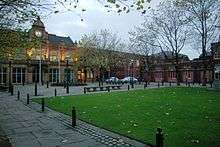
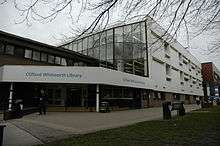
The main Peel Park campus is less than 1.5 miles (2.4 kilometres) from Manchester city centre on the banks of the River Irwell, adjacent to Peel Park, possibly the first public park in the world, which opened on 22 August 1846.[8] A former president of the Students' Union described Salford in 2007 as "a relaxed campus close to Manchester, but cheaper and greener."[9] Salford Crescent railway station is adjacent to the campus, and high frequency bus services operate to Manchester, Salford and Bolton and Liverpool. There are other university facilities within a mile of the main campus, namely the Frederick Road and Adelphi campuses. Most of the university administration buildings are along Salford Crescent, opposite the Peel Campus. The Salford Museum and Art Gallery, said to be the first unconditionally free public library in England.[10][11] is located on the Peel Park Campus.
MediaCityUK
In October 2011 the university opened a learning, teaching and research space at MediaCityUK. Over 1,500 students will have opportunities to work near media professionals using the latest industry specified equipment, studios and laboratories.[12] They will study on 39 undergraduate and postgraduate programmes.[13]
Major investment projects
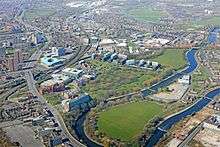
The university embarked on a £150 million programme of investment in 2004, to deliver new buildings and carry out major refurbishment projects. These included:
- £22m Mary Seacole Building, opened in 2006, the purpose-built five storey facility for the College of Health and Social Care.
- £10m Lady Hale Building for the Salford Law School which opened in February 2008. The whole building acts as its own night storage heating and cooling system thanks to a "Termodeck" system.
- £10m Innovation Forum Building
- Joule Physics Laboratory[14] provides a suite of new, purpose-built physics teaching laboratories and is named after James Prescott Joule, whose former home is situated opposite the Peel Building.
- Opened in October 2011 - A new building for the university's College of Arts, Media & Social Sciences designed by 3XN Architects[15] on the MediaCityUK site in Salford Quays - which will be home to five BBC departments.
In summer 2013 construction work started on the £55 million New Adelphi building, due to open in September 2016, housing music, performance, art, design and architecture students. Facilities will include a 350 capacity theatre, 140sqm studio theatre, 2 large TV acting studios, 36 dedicated rehearsal rooms, 6 industry standard recording studios, 12 amplified performance spaces (music ensemble rooms), 2 dance studios, 3 floors of dedicated wood, metal, textiles, print and plastics workshops, 7 photographic studios, 14 instrumental tuition rooms, a double height 100sqm band-room/live room and a suite of flexible performance and studio spaces.
The Library Development Project is being conducted in two stages in 2016 and 2017, encompassing an extension and refurbishment of the Clifford Whitworth Library along the theme of 'the library in the park'.
In May 2016 an extension to the existing Newton Building, which houses the School of Computing, Science and Engineering, was awarded planning permission. The £16 million project, known as the Engineering Showcase, will feature exhibition space to display engineering solutions, research/demonstration spaces, open-plan collaborative learning spaces, informal and formal presentation spaces, a café and ‘maker-space’.
Research and development centres
The United National Institute for Prosthetics and Orthotics Development [16] is located in the University's Prosthetics & Orthotics division of its School of Health, Sport & Rehabilitation Sciences. It is the only prosthetics and orthotics higher education provider in England.
The KidsCan Children's Cancer Research Centre is in the University's John Armstrong Welsh Laboratories at the Centre for Biochemistry, Drug Design and Cancer Research.[17] It was established in 2002 to develop treatments with fewer side effects for children and young adults.[18]
Facilities
Peel Hall has seating for nearly 400 people, hosts many musical performances and is the main venue for the midday recitals. The hall is housed in the Peel Building, a red brick and terracotta Victorian building on the Peel Park Campus.
The university's Robert Powell Theatre, named after the Salford-born actor, mostly stages live performances of modern works and participatory work for younger audiences.
At the heart of the Peel Park Campus, the Chapman Gallery hosts a wide range of modern and contemporary art exhibitions which showcase the work of up and coming artists, university staff, students and the community of Salford.
The Tom Husband Leisure Centre is on the Peel Park Campus and adjacent to the Students' Union. It contains a gym, 25m swimming pool, sauna and spa, squash courts, climbing wall, and a multi-use sports hall.
The Adelphi Studio Theatre is a small theatre venue based in the School of Music, Media and Performance's Adelphi Building.
Organisation
The university is organised into seven schools:[19]
- School of Arts and Media
- Salford Business School
- School of Health Sciences
- School of Nursing, Midwifery, Social Work and Social Sciences
- NB — The University's Schools of Health Sciences and Nursing, Midwifery, Social Work and Social Sciences have strong links with teaching NHS hospitals in the north-west of England and maintain a presence at the Salford Royal Hospital.
- School of Computing, Science and Engineering
- School of Environment and Life Sciences
- School of the Built Environment
International students come from China, India, Pakistan, Saudi Arabia, Cyprus, Greece, Nigeria, the Republic of Ireland, Romania, Malaysia and Bulgaria. With its three colleges, 12 schools, nearly 20,000 students, and over 2,500 staff, Salford had a turnover of some £156m in 2006/07.
The university is a founding member of the Northern Consortium of universities.
In October 2008 it was announced that compulsory redundancies were likely at the university, as part of a plan to save £12.5 million over three years. A notice by the university registrar said that Salford needed to invest £300 million in university estate and £40 million in moving the arts and media faculty to the "MediaCityUK" site at Salford Quays, where the BBC is to establish its northern headquarters. The notice went on to say that these additional costs came in the context of a number of pressures: salary bills that had "exceeded the university's expectations"; a "serious problem" with student retention; the "credit crunch"; and three "seriously underperforming" schools. Affected schools include the School of Nursing, Salford Business School and the School of Community Health Sciences and Social Care .[20]
Teaching quality and rankings
| QS[21] (2016/17, national) | 71 | |
|---|---|---|
| QS[22] (2016/17, world) | 701+ | |
| THE[23] (2016/17, national) | 84 | |
| THE[24] (2016/17, world) | 601-800 | |
| Complete[25] (2017, national) |
=95 | |
| The Guardian[26] (2017, national) |
83 | |
| Times/Sunday Times[27] (2017, national) |
98 | |
In the 2017 Guardian University League Tables, the University of Salford placed 83rd, up from 90th in 2016.[28] The Times newspaper ranked Salford 105th out of 123 UK institutions in 2015, from 84th of 114 in 2010.[29][30]
Student life
Students' Union
University House on the Peel Park Campus is home to the University of Salford Students' Union (USSU). As well as representing students, the union plays host to a number of services, including shops and a bar.
The Two Cities Boat Race is an annual boat race which has been running since 1972. It is now an established event in the sporting and social calendar of Salford and Manchester. The event is also significant for the amount of work put in by volunteers from both universities, to help with event set-up, stewarding, and programme selling, raising money for many different charities. In 2007 the recipient of the proceeds was SPARKS, a charity which supports medical research for children.
In 1971–72, the University Rugby League club won the UAU Championship, beating Sheffield University in the final at The Willows, then home of Salford Rugby League Club.
Accommodation

There are five self-catered halls of residence:
- Peel Park Quarter
- Eddie Colman and John Lester Courts
- Bramall Court
- iQ Salford, Seaford Road
- Sanctuary Students - Tramways, Seaford Road
Peel Park Quarter encompasses nine buildings of flats owned by Campus Living Villages, comprising a total of 1,367 rooms.[31] There are six variations of rooms, including wheelchair accessible en-suite rooms. This complex opened for students in Summer 2015.
Eddie Colman and John Lester Courts are two blocks of flats containing 755 rooms in total, and each flat is shared between two, three or four people. The flats are the closest accommodation to Salford Shopping City in Pendleton – colloquially referred to as the Precinct. Eddie Colman and John Lester Courts were sold by the University of Salford to Campus Living Villages in December 2008. These became CLV's first British properties. Eddie Colman was a resident of nearby Archie Street, the model for the television series 'Coronation Street' and was a player for Manchester United. He was killed in the Munich Disaster of 6 February 1958 along with seven other players.[32][33]
Constantine Court was the only en suite university-owned accommodation, which consisted of 80 rooms in seven houses. This accommodation was in the centre of the main university campus, close to the Students' Union shop, a bank and Salford Crescent railway station. Adjacent Horlock Court comprised 168 rooms in 14 houses.
Bramall Court contains flats close to the Adelphi Campus. The flats are shared between two, three or four. Bramall Court is now owned by Campus Living Villages.[34]
Castle Irwell Student Village was the largest area of accommodation, housing up to 1,600 students, and is on the site of the old Manchester Racecourse.[35] Castle Irwell was a popular choice for first years, due to the cheap rent, however Castle Irwell is no longer in use and has been superseded by the on-campus Peel Park Quarter.
iQ Salford, Seaford Road is owned and run by iQ Student Accommodation in partnership with the university. This accommodation site consists of a square of houses around a central reception, lounge and laundry building, with an independent gym. Each house contains six flats, which are typically shared by six people with en suite bathrooms. The site also has deluxe rooms available for an extra cost. This accommodation is very close to Castle Irwell. The site includes purpose built SPAR, Subway and Greggs shops.
Tramways, Seaford Road is independently run by Sanctuary Students. Its name originates from the old tram depot, run by Manchester Corporation Tramways, that was located on the same site.
Academic staff
- Allan Boardman: Physicist
- Ralph Darlington: Employment relations
- Trevor Cox: Acoustic engineer and broadcaster
- Garry Crawford: Professor of Cultural Sociology
- David Forrest: Economist; specialist in gambling studies
- Peter Graham: Professor of Composition
- Neal Hazel: Professor of Criminology and Criminal Justice
- Andy Miah: Professor of Science Communication & Future Media
- Sarah Moore: Broadcast technology
Notable alumni
Academia
- Michael Atchia: Mauritian academician, former Chief and Programme Director with the United Nations Environment Programme
- Sydney Chapman: British mathematician and geophysicist
- Robert Garner: Professor of political theory at the University of Leicester
- Robert Lomas: writer, business studies and science academic, Freemasonry researcher
- Susan Price: Vice-Chancellor of Leeds Beckett University
Business
- Andrew James Bond: Former Chief Executive of Asda[36]
- Keith Ludeman: Chief Executive of the Go-Ahead Group
- Chris Moyes: Former Chief Executive of the Go-Ahead Group
- Richard Parry-Jones: former group vice president-Global Product Development, and Chief Technical Officer, Ford Motor Company
- Mohammad Hashem Pesaran: British-Iranian economist.
- Mohammed Rahif Hakmi: Chairman of Armada Group[37]
- Richard Tice: CEO of CLS Holdings and co-founder of Leave.EU
Media, entertainment and design
- Sophie Abelson: Actress
- Ross Adams; Actor on BBC3 TV series The Gemma Factor
- Emma Atkins: Actress
- Chris Bisson: Actor
- Wes Butters: Writer and radio broadcaster
- Nigel Clarke: Associate Composer to the Band of HM Grenadier Guards
- Trisha Cooper: Radio trainer, producer and broadcaster
- Rudi Dharmalingam: Actor
- Sophia Di Martino: Actress
- Andrew Diey: Electronic musician, sound designer and record producer
- Jay Diggins: Singer songwriter
- Jason Done: Actor
- Christopher Eccleston: Actor
- Steve Edge: Comedian and actor
- Albert Finney: Honorary degree 13 July 1979. (Born and raised in Salford)
- Stephen Fretwell: Musician (studied at the university, but didn't complete)
- James Gourlay: conductor and internationally renowned tuba soloist
- Sarah Greene: TV presenter
- John Hammond: BBC weather presenter
- Matt Healy: Actor
- Joanna Higson: Actress
- Rob James-Collier: Actor
- Sara Jones: Actress, promoter and Miss Manchester 2009
- Peter Kay: Comedian
- Sir Ben Kingsley: Actor
- Frances Lennon MBE: Artist
- John Vernon Lord: Illustrator and author
- L. S. Lowry: Artist, studied at the Salford Royal Technical College, was awarded the honorary degree of Doctor of Letters in 1975
- Karl Lucas: Comedian, writer, actor
- Conor McNamara: Football commentator for the BBC
- Jason Manford: Manchester comedian and Perrier nominee
- Sarfraz Manzoor: Writer, journalist and documentary maker
- Johnny Marr: Former guitarist with The Smiths
- Kristyna Myles: Singer-songwriter (studied Popular Music and Recording)
- Gitau wa Njenga: Journalist and founder of Jambo Magazine
- Jon Ormerod: Punk rock singer
- Maxine Peake: Actress
- Robert Powell: Actor
- Nigel Pivaro: Former actor, Edinburgh Fringe First winner, producer, journalist Studied as mature student for honours degree in Con Military and International History, attaining 2.1
- Jen Pringle: TV presenter on Channel 5 children's show Milkshake!
- Caroline Redman Lusher: Singer/songwriter, founder and Director of Rock Choir
- John Robb: Musician and journalist
- Samantha Siddall: Actress
- Richard Smith: Scottish screenwriter and film director
- Rosie Smith: Former keyboardist in Cradle of Filth
- Ash Soan: Drummer
- Jim Sturgess: Actor[38]
- Jonathan Thompson: TV presenter
- Kaye Wragg: Actress
- Neil Yates: Jazz and folk musician
- Liam Fray: Lead singer and songwriter for the Courteeners
Military
- Major General William Moore CBE 1976-79.
Physiotherapy
The University has held a link for Physiotherapy with the Professional Footballers' Association since 1991.[39] As of 2007 over 70 former professional footballers have graduated from Salford. In 2009 the PFA reported that they had 33 members undertaking the programme at the University.[40]
- Nigel Adkins: current manager of Southampton.
- Chris Banks, physiotherapist at Stoke City.
- Andy Barr: most recently Head Physiotherapist at Bolton Wanderers[41]
- Matt Barrass
- Gregg Blundell: current Physiotherapist with Tranmere Rovers.[42]
- Jon Bowden
- Kieran Charnock
- Jeff Clarke[43]
- Lee Collins
- Simon Farnworth
- Neil Foster: former England cricketer who played in 29 Tests and 48 ODIs from 1983 to 1993.
- Ashley Fickling[44]
- Ali Gibb
- Wayne Gill
- Rick Holden
- Phil Horner: physiotherapist with Blackpool F.C.
- Mark Kilty
- Paul Lake: currently on the medical staff with Bolton Wanderers.[45]
- Steve Macauley
- Lee Martin: physiotherapist with Tranmere Rovers.
- David Moore: physiotherapist with Grimsby Town.
- Jamie Murphy; former Chief Physiotherapist with Manchester City
- Joe O'Neill[46]
- Keith Oakes
- Les Parry: former manager of Tranmere Rovers.
- Richie Partridge
- Mel Pejic: physiotherapist at Bolton Wanderers[47]
- Jamie Pipe: former Derbyshire professional cricketer.
- Jamie Pitman : currently Hereford United physiotherapist.[48]
- Mick Rathbone: former Head of Sports Medicine at Everton.[49]
- Nicky Reid: completed two degrees in Sports Rehabilitation and Physiotherapy.
- Phil Robinson
- Ian Rodgerson: physiotherapist for Hereford United.
- Derek Ryan: Irish former international squash player.
- Paul Showler
- Gary Stevens: former England international.
- Rob Swire: chief physiotherapist at Manchester United.
- Mark Taylor
- Paul Teather
- Stuart Walker: currently a physiotherapist at Aston Villa.
- Steve Whitehall
- Jon Whitney: club physiotherapist at Walsall[50]
- Ian Wilkinson
- Jon Worthington
- Rodger Wylde: physiotherapist for Stockport County.[51]
Politics
- Anwar Choudhury: British diplomat, former British High Commissioner to Bangladesh
- David Clark, Baron Clark of Windermere
- Stuart Drummond: Three times elected mayor of Hartlepool
- Andrew Gwynne: Labour Member of Parliament for Denton and Reddish
- George Howarth: Labour Member of Parliament for Knowsley North and Sefton East
- Barbara Keeley: Labour Member of Parliament for Worsley and Eccles South
- Alok Sharma: British Conservative Party politician and Member of Parliament for Reading West.
- Ruth Turner: Labour political advisor; co-founder of The Big Issue in the North
- Jae-Chan Jung the chairperson of the fair trade commission, the Republic of Korea
Science
- Darwin Caldwell: Research Director, Italian Institute of Technology, key person in iCub project
- B. N. Suresh (Byrana Nagappa Suresh): Indian aerospace scientist; 2002 recipient of Padma Shri
Sports
- Nigel Adkins: former Wigan footballer who studied Physiotherapy
- Ieuan Evans: Former international rugby union player for Wales[52]
- Su Maozhen: Assistant coach of the Chinese Olympic football team for Beijing Olympics, current head coach of U-20 national team
- Norman Whiteside: former Manchester United and Northern Ireland footballer who studied Podiatry
References
- ↑ "Financial Statements for the year ending 31 July 2015" (PDF). University of Salford. p. 24. Retrieved 4 October 2016.
- 1 2 3 "2014/15 Students by HE provider, level, mode and domicile" (XLSX). Higher Education Statistics Agency. Retrieved 19 January 2016.
- ↑ Baseline Retrieved on 19 March 2009
- ↑ "Royals visit Manchester". Manchester Evening News. M.E.N. Media. 28 February 2008. Retrieved 25 September 2008.
- 1 2
- ↑ "Professor Sir Martin Harris CBE, DL: The Chancellor". University of Salford. Retrieved 29 April 2008.
- ↑ "Amnesty International's Secretary General becomes the University of Salford's new Chancellor". University of Salford. Retrieved 10 July 2009.
- ↑ City of Salford's Parks. Date of page creation:6 August 2007. Retrieval Date: 1 October 2007.
- ↑ The Times Online, Review of the University of Salford. Date of page creation:21 September 2007. Retrieval Date: 1 November 2007.
- ↑ manchesteronline: Eye witness in Manchester Retrieved on 2008-09-05
- ↑ "Report of the Lead Member for Planning to Council on 21st May 2008". Salford. Retrieved 7 June 2015.
- ↑ "University of Salford to move 39 courses to new MediaCityUK campus | Media news". Journalism.co.uk. 2010-08-05. Retrieved 2011-12-27.
- ↑ "Programmes | University of Salford - A Greater Manchester University". Mcuk.salford.ac.uk. Retrieved 2011-12-27.
- ↑ Physics at the University of Salford
- ↑ "2XWinners". arcspace.com. Retrieved 16 September 2009.
- ↑ UNIPOD
- ↑ Biomedical Sciences Research. Centre for Biochemistry, Drug Design and Cancer Research. University of Salford, p. 1
- ↑ KidsCan, 2002, p. 2
- ↑ http://www.salford.ac.uk/about-us/corporate-information/leadership-and-management/schools-and-colleges
- ↑ Jobs threatened as Salford looks to save £12.5 million
- ↑ "QS World University Rankings 2016/17 - United Kingdom". Quacquarelli Symonds Ltd. Retrieved 7 September 2016.
- ↑ "QS World University Rankings 2016/17". Quacquarelli Symonds Ltd. Retrieved 7 September 2016.
- ↑ "World University Rankings 2016-17 - United Kingdom". Times Higher Education. Retrieved 21 September 2016.
- ↑ "World University Rankings 2016-17". Times Higher Education. Retrieved 21 September 2016.
- ↑ "University League Table 2017". The Complete University Guide. Retrieved 25 April 2016.
- ↑ "University league tables 2017". The Guardian. 23 May 2013. Retrieved 23 May 2016.
- ↑ "The Times and Sunday Times University Good University Guide 2017". Times Newspapers. Retrieved 23 September 2016.
- ↑ "University league tables 2017". The Guardian. 2016-05-23. ISSN 0261-3077. Retrieved 2016-07-31.
- ↑ "The Times and Sunday Times University League Tables". The Times and Sunday Times. Retrieved 11 December 2014.
- ↑ Watson, Roland; Elliott, Francis; Foster, Patrick. "University Rankings League Table 2010". London: The Times. Retrieved 9 April 2010.
- ↑ Manchester, University of Salford,. "£81m Peel Park Quarter officially opened | University of Salford, Manchester". www.salford.ac.uk. Retrieved 2016-07-31.
- ↑ University of Salford Accommodation website
- ↑ Loo, Daryl. "Student homes shine amid Europe property gloom." Reuters. Friday 10 July 2009. Retrieved on 5 October 2011.
- ↑ CLV Salford website
- ↑ "Racecourse opponents hold meeting". BBC News. 5 December 2008.
- ↑ "Cranfield University Honours Key Industry and Business Professionals". Tmcnet.com. Retrieved 2011-12-27.
- ↑ "Mohammed Rahif Hakmi".
- ↑ "Santa Monica Mirror - News, Sports, Arts, Schools, Video and More". Smmirror.com. Retrieved 2011-12-27.
- ↑ "Careers after football: former players tell us how they made the grade!" Professional Footballers' Association
- ↑ "Premier League Learning News: Now is the time to plan for future", Premier League Learning
- ↑ Frost, Richard (10 October 2004). "Injury doesn't Barr Andy's career". Manchester Evening News. M.E.N. Media.
- ↑ "New Physio For Rovers". Tranmere Rovers FC. 21 June 2011. Retrieved 21 June 2011.
- ↑ "Backroom Staff". Dundee United FC. Retrieved 2011-12-27.
- ↑ "Footballers | Where Are They Now? | Sheffield United | F". Where-are-they-now.co.uk. Retrieved 2011-12-27.
- ↑ "City legend Paul Lake relishing life back in the top flight". Daily Mail. London. 30 November 2007.
- ↑ Guiseley AFC. "Forwards". Guiseley AFC. Retrieved 2011-12-27.
- ↑ "Bolton Wanderers | Team | Backroom Staff Profiles | Backroom Staff Profiles | Mel Pejic". Bwfc.co.uk. Retrieved 2011-12-27.
- ↑ "Physio Pitman looks to inspire Hereford | The Football Ramble Blog". Thefootballramble.com. 2010-10-18. Retrieved 2011-12-27.
- ↑ "Full circle for 'Baz'". TheFA.com. 2011-05-09. Retrieved 2011-12-27.
- ↑ "Walsall | Team | Managerial Team Profiles | Managerial Team Profiles | JON WHITNEY". Saddlers.co.uk. Retrieved 2011-12-27.
- ↑ "Having a ball". Times Higher Education. 1995-11-24. Retrieved 2011-12-27.
- ↑ "Ieuan Evans". BBC South West Wales. February 2009. Retrieved 19 January 2012.
External links
| Wikimedia Commons has media related to University of Salford. |
- University of Salford – official website
- University of Salford Students' Union – official website
Coordinates: 53°29′04″N 2°16′17″W / 53.48444°N 2.27139°W
.jpg)

